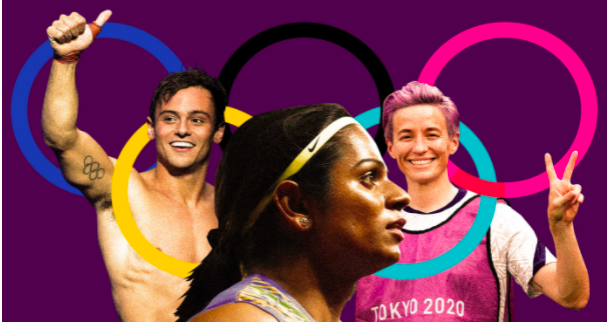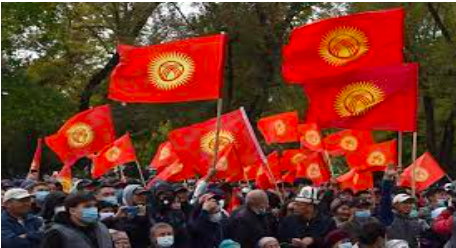Rainbow Olympics: The Changing Dynamics of the Sporting Culture
Posted on : September 7, 2021Author : Akanksha Tiwari

The Tokyo Olympics 2020 was nothing less than remarkable and revolutionary. It managed to garner large-scale attention not only because it was deferred for a year and conducted during the pandemic but also because it witnessed the first-ever gender-balanced Olympic games in history. A total of 185 openly gay, lesbian, bisexual, transgender, queer, and nonbinary athletes contested in the Summer Olympic Games in Tokyo, triple the number that competed in the 2016 Rio Games. Some well-known athletes, such as Megan Rapinoe of the FIFA Women’s World Cup, Brittney Griner of the Women’s National Basketball Association, and diver Tom Daley were joined by up-and-comers like Quinn, a Canadian soccer player, and Laurel Hubbard, a transgender weightlifter from New Zealand.
The Olympics was not always very welcoming towards the LGBTQ+ community until the International Olympic Committee (IOC), in 2004, finally approved and recognized the inclusion of trans athletes who wish to participate. But, according to the 2004 regulations, trans athletes could only be eligible to compete if they underwent reassignment surgery followed by at least two years of hormone therapy. Although bottom surgery was no longer a mandate from 2015 onwards, Hormone Replacement Therapy (HRT) since remained a persistent eligibility criterion.
The above mentioned “sex testing” procedures have predominantly regulated and restricted women’s participation in sports for decades. These unethical practices have breached several human rights and fundamental rights such as the right to privacy, dignity, health, non-discrimination, freedom from ill-treatment, and employment. Sex testing regulations demand painful and unnecessary medical procedures that put an athlete’s human rights, wellbeing, and dignity at stake. These policies scrutinize and coerce athletes into taking drastic steps that involve compromising their basic human rights or, in most cases, withdrawing from the sport.
In 2018, South African sprinter, two-time Olympic gold medallist and three world championship titles winner, Caster Semenya, was prohibited from competing in world championships by the International Association of Athletics Federations (IAAF) because of higher levels of testosterone produced by her naturally. She filed three legal challenges to the rules, calling them unfair and discriminatory, as well as a complaint with the European Court of Human Rights, in order to be given a fair chance to compete in the Tokyo Olympics’ 800-meter event. However, the high-profile athlete was barred from participating in the Summer Olympics simply because she completely refused to lower her testosterone levels artificially. But Semenya was not the only one. Two 18-year-old Namibian track and field athletes, Christine Mboma and Beatrice Masilingi were prevented from racing in the women’s 400m race at the Tokyo Games also because of producing higher levels of testosterone naturally. The teenagers were absolutely devastated since neither of them had been tested previously, and had no reason to think their hormone levels were not within the typical range. It is unfair and unacceptable to coerce someone into taking life-altering measures that hold the potential of taking away the ability of that individual to perform something they are good at. Masilingi further stated that “I would ruin the way my body develops because that’ll be something that rearranges everything – how my body functions and everything.”
It must be noted that testosterone alone cannot be the only factor that enhances athletic performance. Research suggests that when a group of professional male athletes with various testosterone levels compete, those with greater levels don’t necessarily do better than those with lower levels. The same is true for elite female athletes. Dr Richard Holt, professor in diabetes and endocrinology at the Faculty of Medicine at the University of Southampton, said that “There are a number of genetic polymorphisms – slight changes in the genes – that will actually determine whether somebody has that innate ability to be able to compete at the elite level.” Furthermore, an athlete must undergo medications like Metformin and Spironolactone, monthly injections or surgery to lower their testosterone levels. But the process comes with several side effects such as the increased risk of depression, liver injury, hepatitis, and many more. One of the reasons Semenya resisted the new IAAF standards was because of these negative side effects.
Besides the medical implications, these regulations also further their discriminatory agenda towards women since no such stipulations and regulations are imposed on men. Moreover, a policy that requires women’s naturally occurring hormone levels to be monitored and examined for evidence of testosterone and viewing them as “masculine” is a form of policing women’s bodies and casting judgements on their “femininity” along with their gender and sex characteristics. These have often led to self-questioning, humiliation, trolls, withdrawal from sports, and attempting suicide. Rumours created and projected by the media have often resulted in negative mental pressure and raised suspicions about an athlete’s gender identification, causing them to be rejected by their family and community. For example, Annet Negesa, a Ugandan athlete, had to flee her country to avoid abuse because of her sex differences. Thus, it can be concluded that sex testing strategies are largely unscientific, unethical, immoral, and degrading.
Despite such hindrances, it is safe to say that Olympics or other globally conducted sporting events are making long strides to incorporate and welcome LGBTQ+ athletes in recent years. On 26 April 2016, the International Olympic Committee (IOC) released a statement on ‘Harassment and Abuse (Non-Accidental Violence) in Sport’ acknowledging that “elite, disabled, child and lesbian/gay/bisexual/trans-sexual (LGBT) athletes are at highest risk” of becoming the victims of psychological and physical harassment. In order to curb the harassment, the focus should be on improving the culture of sports that is inculcated into younger athletes. A culture of acceptance of LGBTQ+ people and elimination of homophobic slurs like “Oh, that’s gay!” must come into practice. Erik Denison, a behavioural scientist at Monash University in Australia opined that such habits normalize the toxic sports culture and send a message that such language is harmless and set the belief that all members of the teams are heterosexual. He also believed that the culture of homophobia in sports, affecting both men and women, started in the nineteenth century. Denison claims that although men were encouraged to participate in athletics to exercise their aggression and superiority, women were discouraged from doing so. It was assumed that such severe physical activity might prevent them from having children. Moreover, women who disobeyed the advice and participated in sports were assumed to be lesbians who would not give birth.
However, the eradication of homophobic stereotypes and recognition of trans-athletes is a result of the advent of social media providing the LGBTQ+ athletes with a platform to celebrate and embrace who they are. The internet’s limitless space has aided athletes in immediately connecting with their supporters and admirers, influencing them to embrace and love their individuality. Sport has the power to inspire millions of young people, and watching LGBTQ+ Olympians perform on a global stage promotes the idea of equality and inclusion amongst youth.
Akanksha Tiwari
Intern Asia in Global Affairs
References
- Abhijit Nair, “How trans-athletes revolutionised the Tokyo Olympics,” The Bridge, 8 August 2021 <https://thebridge.in/tokyo-2020/how-trans-athletes-revolutionised-24301?infinitescroll=1> (Accessed 25th August, 2021)
- Amy Gunia, “Record Number of LGBTQ Athletes Set to Compete at the Tokyo Olympics,” Time, 13 July 2021 <https://time.com/6079508/olympics-lgbtq-athletes-record/> (Accessed 25th August, 2021)
- Scottie Andrew, “There may be more Olympians who identify as LGBTQ than ever before. But there are limits to inclusion,” CNN, 28 July 2021 <https://edition.cnn.com/2021/07/28/sport/lgbtq-athletes-2020-olympics-spt-trnd/index.html> (Accessed 25th August, 2021)
- “At least 185 out LGBTQ athletes were at the Tokyo Summer Olympics, more than triple the number in Rio,” Outsports, 15 August 2021 <https://www.outsports.com/olympics/2021/7/12/22565574/tokyo-summer-olympics-lgbtq-gay-athletes-list#comments> (Accessed 26th August, 2021)
- “IOC rules transgender athletes can take part in Olympics without surgery,” The Guardian, 25 January 2016 <https://www.theguardian.com/sport/2016/jan/25/ioc-rules-transgender-athletes-can-take-part-in-olympics-without-surgery> (Accessed 26th August, 2021)
- Canela López, “Until 2016, trans Olympics athletes had to have bottom surgery. Now advocates are calling to scrap hormone requirements too,” Insider, 24 June 2021 <https://www.insider.com/trans-olympic-athletes-no-longer-need-surgery-hormones-still-required-2021-6> (Accessed 26th August, 2021)
- Samantha Granville, “Namibian teens vow to fight Olympics testosterone ban,” BBC News, 7 July 2021 <https://www.bbc.com/news/world-africa-57748135> (Accessed 26th August, 2021)
- ““They’re Chasing Us Away from Sport”: Human Rights Violations in Sex Testing of Elite Women Athletes,” Human Rights Watch, 4 December 2020 <https://www.hrw.org/report/2020/12/04/theyre-chasing-us-away-sport/human-rights-violations-sex-testing-elite-women> (Accessed 26th August, 2021)
- Gerald Imray, “Semenya misses Tokyo, may be forced out of Olympics for good,” AP News, 3 July 2021 <https://apnews.com/article/africa-olympic-games-2020-tokyo-olympics-sports-c11b5fba248c03ea6ddd7e7089818eb0> (Accessed 27th August, 2021)
- Sarah Farrell, “How do IAAF regulations affect female athletes with high testosterone levels?” Global Sports Matters, 15 November 2019 <https://globalsportmatters.com/health/2019/11/15/iaaf-regulations-for-female-athletes-with-high-testosterone/> (Accessed 27th August, 2021)
- “The IOC Consensus Statement: harassment and abuse (non-accidental violence) in sport,” Olympics, 28 April 2017 <https://stillmed.olympic.org/media/Document%20Library/OlympicOrg/IOC/What-We-Do/Protecting-Clean-Athletes/Safeguarding/IOC-Consensus-Statement_Harassment-and-abuse-in-sport-2016.pdf> (Accessed 27th August, 2021)
Edward (Ted) M. Kian, “The Success of LGBT Athletes in the Sports Media,” Research Gate, January 2019 <https://www.researchgate.net/publication/329169900_The_Success_of_LGBT_Athletes_in_the_Sports_Media> (Accessed 27th August, 2021)



